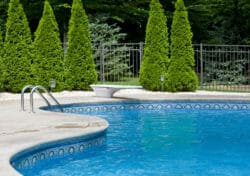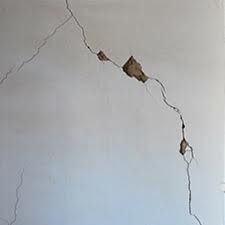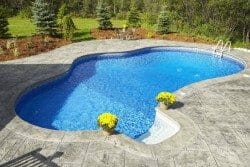How To Tell If A Swimming Pool Is Level
Home » Pools and Spas »

Many swimming pools are slightly out of level and under most circumstances it is not a significant problem. If a pool is out of level by a 1/4 to a 1/2 of an inch, most inspectors will not give it much thought, unless there are other issues.
Depending on the inspector, a pool that is out of level 3/4 to one inch may still not be a major concern, however, a pool that is out of level by several inches is a “Red or Yellow Flag” to most inspectors.
Why being out of level may be a concern
Pools are seldom built out of level but become so due to the body shifting. and when the pool shifts, it doesn’t do so uniformly. This lack of shifting uniformly creates additional problems and damage:
- Cracks, including structural cracks in the shell
- PVC underground pipes cracking or separating
- Electrical wires and conduits going to the pool separating
- Copping often gets damaged when a pool shifts
- Skimmers may not work well if a pool is out of level
Infinity pools
Swimming pools that that have one or more edges where the water flows over the edge, usually into a receded trough are referred to as “Infinity Pools.” In these pools the water merges seamlessly into the horizon, sky, or another body of water, such as an ocean or lake.
If a pool’s infinity edge is not level, then the water may only flow over part of the edge and the pool loses much of its charm.
Reasons pools & spa’s become unlevel
The main reasons that pools become out of level is usually related to either soil issues, water table issues or design and engineering.
Soil issues
Uncompacted soil and settlement. A fully filled in-ground concrete gunite or shotcrete pool weights many tons and if the soil that the pool sits on is not well compacted it will often settle
Poor quality soils have very little load bearing capacity when compared to higher quality soils. Dirt is just not dirt; some soils will carry 5 or 6 times the load that other soils carry; thus a pool is more likely to shift on poor quality soils.
Expansive soils. Soils with a clayey content will swell up when wet and shrink when dry. This movement can lift a pool or spa upward in many circumstances and usually this upward movement is not uniform, so one side side or end of the pool becomes higher than the other. ( Read more about expansive soil and the damage it does )
Slope creep. Hillside that are slowly moving downhill, perhaps a 1/4 or 1/2 inch a year, will have a detrimental effect on a pool’s levelness over the years.
Water table issues
Hydrostatic Relief Valve. If a pool is constructed without a Hydrostatic relief valve and the water table rises, there is a possibility of the pool floating up; possibly an inch or even a foot or more. (Read about pools floating up)
Floods and extended periods of heavy rains. When areas incur floods, a number of pools and spas will shift upwards due to the rising water table. The ground becomes totally saturated with water and pools may pop up, especially pools that were empty at the time of the flood or heavy rains.
High water table. Soil that become saturated with water exerts tremendous hydrostatic pressure on pools. Homes with pools that lie in low areas near a lake, river or ocean tend to incur water table issues more than others. However, a high-water table may also be due to an underground stream or even a leaking water pipe saturating the pool area soil.
Here is how to tell if your pool is not level
When a pool is built, there are usually several rows of tile or more around the perimeter; both above and below the water line of the pool. These rows of tile are close to being perfectly level when the pool is first built, but if part of the pool body shifts up or down, then the tile rows are no longer level. However, the water is still perfectly level; that is why you measure from the grout line to the water.
Tip. Many pool tiles will have geometric designs on them, so some people will measure from the water level to a certain part of the design on the tile.
One of the easiest ways to tell if a pool is out level is to look at the water level in relation to the horizontal grout line around the pools edge. You will need a measuring tape to help you measure from the water level to the closet tile grout line to the water level. To get accurate measurements, you want the water to be still with no movement:
- Have the pool equipment turned off
- No children or other people in the pool
- Avoid wind and breezy days, for the water will ripple
Take measurements about every ten to 15 feet around the entire perimeter of the pool and write each measurement down on a rough drawing of the pool shape.
If the water level is down one inch from the grout line at point X, it should be the same one inch all away around the pool. If it’s 2 ½ inches low at the opposite side or end, then the pool would be a I ½ inches out of level. The tile is generally installed level all the way around the pool when it is first built, so it makes a good way to gauge if there has been movement and how much.
Bottom Line
It is not uncommon for pools and spas to be unlevel and if they’re only a little bit out of level, there is generally no reason to be concerned. Should they be significantly out of level and or have cracks, then the un-levelness is much more of a concern, therefore doing a quick levelness check is wise and easy.












I had some concrete finishing around my inground pool. The slope has been changed in a few areas. The water drains into the pool. The water is suppose to drain away from pool correct? What is the standard and how do I get this fixed?
We have a 4 filter system for a pool, generally they are designed to limit the need to backwash/clean to waste. The pool installers have not supplied the pool with an outlet to do this. The copers are not sealed underneath and have no expansion joints. Is this acceptable